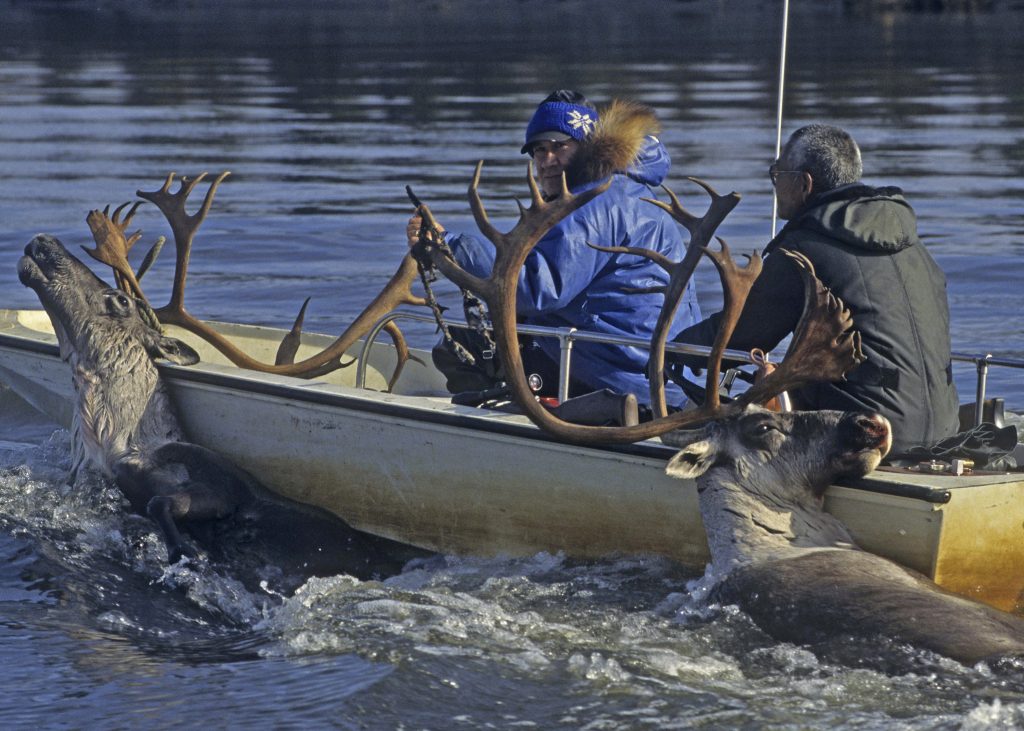The late Clara Lee cuts fish outside her Ambler home. The racks hold pike, whitefish, and sheefish in the first stages of drying into paniktak. Photo by Nick Jans.
I sat in Zach Hugo’s kitchen on a bitter April day. My traveling partner Clarence Wood and I had just arrived in the village of Anaktuvuk Pass on the first leg of a thousand-mile snowmachine trip, and of course been met with typical Inupiaq hospitality. As a ground blizzard howled outside, Nunamiut elders filed in to greet their old friend Clarence. Zach’s wife, Doris, bustled about, attending to the all-important business of feeding her guests. She ladled bowls of caribou soup from a steaming pot and set out a box of Sailor Boy pilot bread. Then, wielding her ulu, she splayed flat a large cardboard box on the floor and set down a whole frozen char, which she deftly carved into chunks, along with saucers of usruk (seal oil), a can of just-opened green peas for a garnish, and salt. “Come eat kauk,” she gestured, and everyone sat on the floor in a circle, using fingers and knives as they bent over the raw, frozen fish, cutting and dipping, murmuring in appreciation. Noting my hesitancy with the seal oil, Doris stage-whispered, “Don’t worry—it’s fresh!” And everyone laughed at the naluaqmiu, delicately nibbling thin-cut-slices, chasing each bite with dry pilot bread. “Too full from that good soup!” I replied. No one was fooled. I was back then, and always have been, just okay with kauk, and a seal oil wimp.
Eskimo food, as the villagers themselves call it, shares one immutable characteristic: it’s gathered from the land, an expression of the seamless connection between The People and the boundless country they’ve always called home. Though what the elders call “store food” has been increasingly folded into local diets since it first became available in the mid to late 1800s, the Inupiat, along with other Alaska Native peoples, can be counted among the last hunter-gatherer societies on earth. Animal protein, plus berries and edible plants, forms the cornerstone of their diet and cultural identity. Take away food from Outside, and they’d adapt. But without food from the land, they’d be impoverished, spiritually and physically. The People truly are what they eat. The elders of passing and past generations, far more so.
Even to the unadventurous palate, some Eskimo foods are easy to like, tending a bit bland in a place where salt and pepper count as big spice. Caribou, moose, or goose soup, usually augmented with a few canned veggies, pasta, or spuds, ranks high on that list of good stuff—as long as you don’t look too closely into the pot on the wrong occasion. I recall a broth served by a friend that prominently included duck heads and necks, inspiring a tantrum from his three-year-old, who began screaming after she peered into her headless bowl, Daddy, I want a head! I want heads only! I was happy to slip her one of mine.
And of course, well-prepared roasted or fried meat or fish is better than fine—the latter frequently cooked whole, guts in (where much nutritious fat is stored). No worries. You can pick around those parts if you want. Dried raw meat (paniktak), usually caribou or fish, is a staple I’ve long enjoyed by the bagful. Hey, it’s just old-school jerky. The aforementioned seal oil, usruk, ranks as a universal condiment and fat source; and if fresh, reminds one of fishy olive oil. But with age, it becomes much stronger, sometimes overpowering, both in its distinctive odor and taste. Maktaq, small chunks of bowhead whale skin with a small amount of fat attached, follows the same scale—at its best, mild and vaguely nutty, though like any fat, incredibly rich and hard on some digestions, including mine.
Some traditional foods I leave to the more adventurous. They’re a nod to another time, when little was wasted. I recall attending the 80th birthday party of my Noatak neighbor and friend, Emma Porter, about 35 years ago. Most folks there were real old-time elders; and toward the end of the party, one brought forth a delicacy to match the crowd: a chunk of tuktak—walrus flipper that had been carefully fermented for weeks in a Ziploc bag (once it would have been a walrus skin) until it was green and furry. When he opened, it, an eye-watering odor filled the air—enough that some elders fled the room and propped open the storm shed door, waving their hands. Akaa—it stinks!—they laughed. Several guests partook of slivers, which they pronounced delectable. It was their version of limburger cheese. Under the circumstances, I was able to decline a sample without losing face.

I hadn’t been so lucky the year before, at the Thanksgiving feast at the Noatak Friends Church—a communal affair featuring all manner of food, from roast turkey with all the trimmings to moose nose (which is exactly as you’d expect). I was approached by my friend Wendell Booth, Sr., who was taking his turn serving food down the rows of pews.
“What’s in the pot?” I asked.
“Boiled bear fat,” he beamed, and ladled a rubbery cube onto my plate. With Wendell watching expectantly, I forked it into my mouth and bit down. It bounced back. Again. The same. That tough old grizzly had obviously been eating rancid salmon. And chew as I might, it wouldn’t go away and was too big to swallow. Wendell turned his head and I spit it inside my shirt. “Aarigaa!” I smiled. Good!
So go ahead—call me an intercultural culinary weenie if you want. I plead guilty as charged.


Comments are closed.